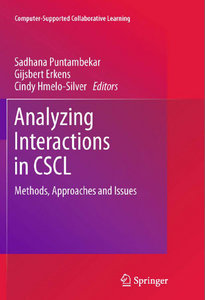Analyzing Interactions in CSCLMethods, Approaches and Issues
|

|
 Diese Seite wurde seit 2 Jahren inhaltlich nicht mehr aktualisiert.
Unter Umständen ist sie nicht mehr aktuell.
Diese Seite wurde seit 2 Jahren inhaltlich nicht mehr aktualisiert.
Unter Umständen ist sie nicht mehr aktuell.
 Zusammenfassungen
Zusammenfassungen
 Analyzing Interactions in CSCL: Methodology, Approaches, and Issues deepens the understanding of ways to document and analyze interactions in CSCL and informs the design of the next generation of CSCL tools. It provides researchers with several alternative methodologies, theoretical underpinnings of the methods used, data indicating how the method worked, guidance for using the methods, implications for understanding collaborative processes and their effect on learning outcomes and implications for design. CSCL research tends to span across several disciplines such as education, psychology, computer science and artificial intelligence. As a result, the methods for data collection and analysis are interdisciplinary, from fields such as sociology, anthropology, psychology, computer science, and artificial intelligence. This book brings perspectives together, and provides researchers with an array of methodologies to document and analyze collaborative interactions.
Analyzing Interactions in CSCL: Methodology, Approaches, and Issues deepens the understanding of ways to document and analyze interactions in CSCL and informs the design of the next generation of CSCL tools. It provides researchers with several alternative methodologies, theoretical underpinnings of the methods used, data indicating how the method worked, guidance for using the methods, implications for understanding collaborative processes and their effect on learning outcomes and implications for design. CSCL research tends to span across several disciplines such as education, psychology, computer science and artificial intelligence. As a result, the methods for data collection and analysis are interdisciplinary, from fields such as sociology, anthropology, psychology, computer science, and artificial intelligence. This book brings perspectives together, and provides researchers with an array of methodologies to document and analyze collaborative interactions. Kapitel
Kapitel 
- 1. A Complexity-Grounded Model for the Emergence of Convergence in CSCL Groups (Seite 3 - 23) (Manu Kapur, John Voiklis, Charles K. Kinzer)


- 2. Analyzing the Contextual Nature of Collaborative Activity (Seite 25 - 46) (Maarit Arvaja)


- 3. Understanding Learners´ Knowledge Building Trajectory Through Visualizations of Multiple Automated Analyses (Seite 47 - 82) (Nancy Law, Johnny Yuen, Wing O. W. Wong, Jing Leng)


- 4. Representational Tools for Understanding Complex Computer-Supported Collaborative Learning Environments (Seite 83 - 106) (Cindy Hmelo-Silver, Rebecca Jordan, Lei Liu, Ellina Chernobilsky)


- 5. How to Study Group Cognition (Seite 107 - 130) (Gerry Stahl)


- 6. Thinking about Methods to Capture Effective Collaborations (Seite 131 - 142) (Stephanie D. Teasley)


- 7. Analyzing Collaborative Processes and Learning from Hypertext Through Hierarchical Linear Modelling (Seite 145 - 159) (Agni Stylianou-Georgiou, Elena Papanastasiou, Sadhana Puntambekar)


- 8. Analyzing Collaborative Interactions with Data Mining Methods for the Benefit of Learning (Seite 161 - 185) (Peter Reimann, Kalina Yacef, Judy Kay)


- 9. Multilevel Analysis in CSCL Research (Seite 187 - 205) (Jeroen Janssen, Gijsbert Erkens, Paul A. Kirschner, Gellof Kanselaar)


- 10. Sequential Analysis of Scientific Argumentation in Asynchronous Online Discussion Environments (Seite 207 - 233) (Wooseob Jeong, Douglas B. Clark, Victor D. Sampson, Muhsin Menekse)


- 11. Is the Whole Greater than the Sum of Its Parts? - Explaining the Role of Individual Learning and Group Processes in CSCL (Seite 235 - 243) (Susanne Lajoie)


- 12. Quantifying Qualities in Collaborative Knowledge Construction - The Analysis of Online Discussions (Seite 247 - 268) (Karsten Stegmann, Frank Fischer)


- 13. An Interaction-Aware Design Process for the Integration of Interaction Analysis into Mainstream CSCL Practices (Seite 269 - 291) (Alejandra Martínez-Monés, Andreas Harrer, Yannis Dimitriadis)


- 14. A Framework for Assessment of Student Project Groups On-Line and Off-Line (Seite 293 - 317) (Gahgene Gweon, Soojin Jun, Joonhwan Lee, Susan Finger, Carolyn Penstein Rosé)


- 15. Analyzing Productive Interactions in CSCL - Collaborations, Computers and Contradictions (Seite 319 - 339) (Eileen Scanlon)


- 16. Tracing Interaction in Distributed Collaborative Learning (Seite 341 - 366) (Dan Suthers, Richard Medina)


- 17. Analyzing Collaborative Interactions Across Domains and Settings - An Adaptable Rating Scheme (Seite 367 - 390) (Nikol Rummel, Anne Deiglmayr, Hans Spada, Georgios Kahrimanis, Nikolaos Avouris)


- 18. Analytical Frameworks for Group Interactions in CSCL Systems (Seite 391 - 411) (Kristine Lund)


 Dieses Buch erwähnt ...
Dieses Buch erwähnt ...
 Personen KB IB clear | Daniel Kahneman , Amos Tversky | ||||||||||||||||||
 Begriffe KB IB clear | CSCLComputer-Supported Collaborative Learning
,  Hypertext Hypertext hypertext
, Informatikcomputer science
, hypertext
, Informatikcomputer science
,  Künstliche Intelligenz (KI / AI) Künstliche Intelligenz (KI / AI) artificial intelligence
, artificial intelligence
,  Lernen Lernen learning
, learning
,  machine learning
, Simulation
, social network analysissocial network analysis
, machine learning
, Simulation
, social network analysissocial network analysis
,  Statistik Statistik statistics
, statistics
,  Visualisierung Visualisierung visualization visualization
| ||||||||||||||||||
 Bücher |
| ||||||||||||||||||
 Texte |
|
 Dieses Buch erwähnt vermutlich nicht ...
Dieses Buch erwähnt vermutlich nicht ... 
 Nicht erwähnte Begriffe | Bildung, Digitalisierung, Informatik-Didaktik, Informatik-Unterricht (Fachinformatik), Kinder, LehrerIn, Schule, Unterricht |
 Tagcloud
Tagcloud
 Zitationsgraph
Zitationsgraph
 Zitationsgraph (Beta-Test mit vis.js)
Zitationsgraph (Beta-Test mit vis.js)
 3 Erwähnungen
3 Erwähnungen 
- DeLFI 2013 (Andreas Breiter, Christoph Rensing) (2013)
- Peer Assessment und Peer Annotation mit Hilfe eines videobasierten CSCL-Skipts (Niels Seidel) (2013)


- Peer Assessment und Peer Annotation mit Hilfe eines videobasierten CSCL-Skipts (Niels Seidel) (2013)
- Lernen mit Bildungstechnologien - Praxisorientiertes Handbuch zum intelligenten Umgang mit digitalen Medien (Helmut M. Niegemann, Armin Weinberger) (2019)
- 3. Computerunterstütztes kollaboratives Lernen (Frank Fischer)


- 30. Group Awareness-Tools beim technologieunterstützen Lernen (Daniel Bodemer, Lenka Schnaubert)


- 3. Computerunterstütztes kollaboratives Lernen (Frank Fischer)
 Volltext dieses Dokuments
Volltext dieses Dokuments
 Bibliographisches
Bibliographisches 
 Beat und dieses Buch
Beat und dieses Buch
Beat hat dieses Buch während seiner Zeit am Institut für Medien und Schule (IMS) ins Biblionetz aufgenommen. Beat besitzt kein physisches, aber ein digitales Exemplar. (das er aber aus Urheberrechtsgründen nicht einfach weitergeben darf). Es gibt bisher nur wenige Objekte im Biblionetz, die dieses Werk zitieren.









 , 2078 kByte;
, 2078 kByte;  2020-11-28)
2020-11-28) 



 Biblionetz-History
Biblionetz-History